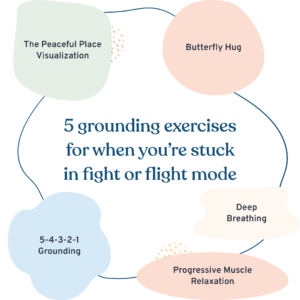5 Quick Exercises for When You’re Stuck in Fight or Flight Mode

Activating the parasympathetic nervous system during times of heightened stress can help us restore a sense of calm, and, ultimately, build resilience against life’s stressors. The good news is, regaining balance doesn’t have to mean adding extra to an already busy agenda. Taking just a few moments to engage in mini exercises can eliminate the toxic effects of ‘fight or flight,’ so you can enjoy extra energy to tackle whatever life throws your way.
Maybe you’re feeling as if you’re constantly putting out fires and can never get caught up. You’re under a slew of unmanageable deadlines. You’re about to hit the stage. Or you’re reliving an experience over and over that shook you to your core. Whatever the case may be, life can sometimes feel like a never-ending series of challenges, which has a tendency to leave us stuck in ‘fight or flight’ if we don’t take the time to hit the reset button and relax a bit.
What does it mean to be stuck in fight or flight?
The fight or flight response is our body’s natural reaction to perceived threats. Whether it’s a far-too-heavy plate to handle, a heated argument, or a traumatic memory of our past that keeps us from feeling peace, this instinct tends to kick in much in the same way it did for our ancestors warding off dangers in their environment. Back then, they may have been fending off a predator in the wild, but the body doesn’t know the difference between this and modern-day stressors.
Driven by the sympathetic nervous system, during fight or flight, the body releases hormones like adrenaline and cortisol, preparing us to protect ourselves by either confronting the threat or running away from it. You might notice your heart racing, shallow breathing, tensed muscles, and a heightened state of alertness.
While this reaction is essential in life-threatening situations, it can become problematic when activated over everyday occurrences. Being chronically stuck in fight or flight lowers distress tolerance levels, and in doing so, even the smallest upset can feel unmanageable, wreaking havoc on heart and gut health, and leading to anxiety, insomnia, and fatigue.
It’s important to find ways to incorporate stress relievers into each day. This may seem next to impossible if you’re already constantly on the go, but luckily, that doesn’t have to be the case. While it would be ideal to carve out an hour or so to do some extended practice, focusing on just a couple of minutes can go a long way.
Here, we’ll introduce the body’s natural mechanism for getting unstuck – the parasympathetic nervous system – as well as mini exercises proven to engage it. By incorporating very small activities into the daily busyness of life, we can induce an immediate sense of calm, releasing fight or flight before it takes a permanent seat inside.
Restoring nervous system balance naturally
Often referred to as the ‘rest and digest’ state, engaging the parasympathetic nervous system is key to conserving energy and regaining balance. When activated, it slows the heart rate, decreases blood pressure, and promotes digestion and relaxation. This system is essential for reducing the harmful effects of prolonged fight or flight and promoting overall well-being.
Simple interventions can easily stimulate this built-in brake system without having to take time away from your obligations. So, the next time you find yourself preparing to tense up, try one of the following to alleviate stress and effectively manage the situation at hand.
Don’t get stuck in fight or flight mode
1. Deep breathing techniques
You may already be familiar with some of the more popular methods for finding peace through deep breathing. However, many tried-and-true techniques require significant focus. If you simply don’t have time to shut the world out, 1 to 2 minutes of belly or box breathing are sure to do the trick.
Belly breathing:
Also known as diaphragmatic breathing, belly breathing engages the diaphragm rather than the chest. Staying right where you’re at – whether that be at your workstation, in the car, or backstage before presenting at an event – inhale deeply through your nose, allowing your belly to rise while keeping your chest relatively still. Exhale slowly through your mouth, letting your belly fall. Do this as many times as you can to improve the flow of oxygen to the brain, lower blood pressure, and enhance mental clarity.
Box breathing:
You might also attempt box breathing, which involves imagining you’re breathing slowly and steadily in a box-like formation. Inhale for a count of 4, hold your breath for a count of 4, exhale for a count of 4, and hold again for a count of 4. Repeat for however long you’d like.
Consider setting aside a few minutes each morning and evening for belly or box breathing if you can’t partake during the day. Over time, you might just find it becomes a natural part of your routine no matter where you’re at.
2. Gaining ground through grounding
Grounding involves quick and easy exercises designed to reconnect your inner self with your surroundings. These exercises remind the mind you’re not in immediate danger through healthy distraction and engaging the senses. With continued practice, grounding has been proven to reduce inflammation, improve sleep, and promote resilience even under the toughest circumstances. Here’s an especially easy-to-remember technique you can use just about anywhere.
5-4-3-2-1 grounding:
Taking just a few seconds of your time, the 5-4-3-2-1 exercise helps to anchor you in the present by identifying five things you can see, four things you can touch, three things you can hear, two things you can smell, and one thing you can taste. All you have to do is focus on finding these in the space around you.
Let’s run through a quick example…
In an office setting, you may see your desk, a computer, a set of chairs, a window, and a stack of papers. You might touch a pen, a notebook, a stapler, or the back of your seat. You hear the muffled voices of coworkers in other rooms, the humming of your space heater, and cars driving past. You smell lunch in the break room and the scent of cleaner lingering from the night before. You can still taste the coffee you sipped from the cup in front of you.
In just a few seconds time, you’ve effectively shifted your focus from feeling distress to remembering you are safe where you’re at. Do this anytime you feel pressure escalating.
3. Finding peace with progressive muscle relaxation
Certain areas of the body tend to tense up under stress. In the past, this tension prepared our ancestors to stay strong in battle. But, of course, if you’re not readying yourself for war, it only serves to reinforce aches associated with anxiety.
Progressive muscle relaxation (PMR) assures each muscle group it won’t be needed, so you’re not left with phantom pains long after the threat has passed. This technique involves concentrating on tensing, and then slowly releasing, each area in turn.
Progressive muscle relaxation 101:
Stay where you’re at and start by tensing your toes for a count of 5-10 seconds, then allow them to release and keep them relaxed for an additional 20 seconds. Work your way up the body, focusing on each of the major muscle groups, including your feet, lower legs, thighs, stomach, chest, back, hands, forearms, biceps, shoulders, neck, face, and the top of your head. If you have a few extra seconds to spare, reverse this process until you’re back to your toes again.
By systematically relaxing the muscles, progressive muscle relaxation will not only induce a satisfying tingling feeling in the muscles but lower your heart rate and blood pressure in the process, so you’re better prepared to tackle what’s ahead.
If you’re in a private space, consider using a guided progressive muscle relaxation recording or app to help you through without having to give the exercise much thought, or you can use headphones to keep the audio to yourself. The more you can focus on simply feeling calm throughout the process, the more effective it’ll be.
4. Restoring tranquility through touch
Humans are born with a natural need for physical touch. This is why, in order to feel protected and thrive in infancy, it’s important to experience the contact comfort of being held and swaddled in our cribs. Even in adulthood, this instinct continues, and a calming sense of touch can be a powerful way to activate the parasympathetic nervous system.
Simple acts like hugging a loved one, holding a warm cup of tea, or using a weighted blanket can be very soothing. Of course, if you don’t have any of these items on hand and feel a bit awkward embracing the people around you, you’ll have to find suitable alternatives to achieve the same effects. Massaging your shoulders or temples a few times might help, or you might consider carrying a small stress reliever with you – like a squishy ball – so you can pull it out whenever needed.
Another easy go-to is the butterfly hug.
The butterfly hug:
Truly as simple as it sounds, the butterfly hug involves embracing yourself by crossing your arms over your chest, then gently tapping your shoulders with your fingertips in a motion similar to the fluttering of a butterfly’s wings. At the same time, engage in some deep breathing and visualize a setting you find soothing.
Often used in Eye Movement Desensitization and Reprocessing (EMDR) therapy, this in-the-moment method for engaging the parasympathetic nervous system relaxes the mind and body before beginning to explore traumatic memories. It can also be very effective for hitting reset before returning to current demands.
5. The value of visualization
Visualization, also called ‘guided imagery,’ involves creating mental images to promote relaxation and mental clarity. Listed as a step in the butterfly exercise above, visualization, in itself, activates the parasympathetic nervous system, fostering a sense of peace inside.
By regularly practicing visualization, you can train your mind to find calm and clarity even when fighting off stressors in the here-and now. Here’s how to get started:
The peaceful place visualization:
Find a comfortable place to sit and close your eyes. Take a few deep breaths while envisioning a place where you feel safe and secure. Home in on the details of this place by using a technique similar to the 5-4-3-2-1 grounding above. Imagine things you might see, hear, smell, feel, and taste, slowly, and in turn. Spend however long you can in this space before opening your eyes, returning to the present, and taking one more deep belly breath.
Getting started on your path to peace
Habits generally take about three weeks to stick. So, in the beginning, it may be easy to forget to turn to the exercises above when you’re feeling stressed. Don’t worry, this is to be expected, especially when there’s a million other to-dos requiring your attention. However, once you get accustomed to using these techniques, you may start to wonder how you ever got by without them.
Tips for integrating some balance back into your day:
- Start small: Choose one technique to begin with and gradually add more along the way.
- Set reminders: Use phone alarms, sticky notes, or email notifications to remind yourself to practice.
- Create a routine: Add these first to your morning and/or bedtime routine. As they become second nature, it will be easier to use them throughout the day.
- Use technology: Consider using apps that will guide you through breathing exercises, relaxation techniques, or visualizations until you get the hang of things.
- Minimize distractions: Whether activating the focus button on your phone, placing a do not disturb sign on your door, seeking out a quiet space in your home, or heading outside for a few, minimizing distractions will improve overall effectiveness.
Take action today
Tired of being stuck in fight or flight? Making an effort to engage the parasympathetic nervous system can go a long way in minimizing fight or flight and maximizing health, and you don’t have to dedicate a ton of time to transforming your routine. Start by incorporating these mini exercises into your day whenever you can, finding and building upon your go-to techniques along the way.
If you feel the need for additional support, remember that it’s okay to reach out instead of enduring challenges alone. Consider reaching out to a mental health professional. A therapist can help guide you through these options and tailor them to your own unique needs. Therapy can also help you discover the sources of your distress so you can eliminate any unhealthy patterns keeping you stuck and heal sustainably.
Ready to prioritize your mental health?
Great Lakes Psychology Group is here to help. With an extensive network of caring therapists available to meet online or in-person, we make it easy to find the right fit for your unique needs.





